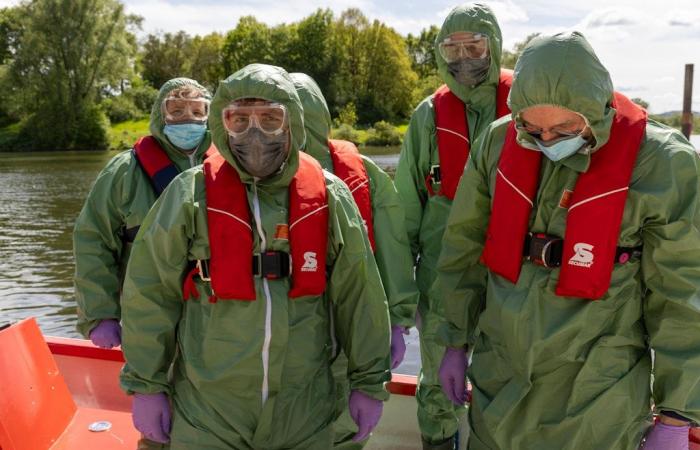Is bird flu the next pandemic? Now a well-known scientist is speaking out about the danger that the next pathogen after Corona could trigger a health crisis. Berlin virologist Christian Drosten from the Charité described the H5N1 virus as a potential candidate for such a global event. The reason is cases in dairy cattle in the USA.
Humans have already been infected with H5N1. “Something like this has never happened before, such extremely large outbreaks in cows – all experts are worried,” Drosten told the editorial network Germany. The spread of bird flu among mammals could also be “mild, the virus needs several steps to adapt, and perhaps it will already be under control beforehand,” Drosten continued. “But it could also be the start of the next pandemic, which we are following live here.”
Good morning Berlin
Newsletter
Thank you for signing up.
You will receive a confirmation by email.
The cases of three employees caused a stir. They had obviously become infected on farms. The employees had come into contact with cows and cow’s milk. Those affected only had mild symptoms. This means that other people could have been infected without noticing it and passed the virus on to other people. However, it is not yet known whether bird flu can be transmitted from person to person.
Recently, a case was also reported in India. According to the World Health Organization (WHO), a four-year-old child became ill. The subtype is influenza A (H9N2). This means that there are two cases on record in India. The authorities there reported the first in 2019. The WHO assumes that at least 889 people in 23 countries have been infected with H5N1 over the past two decades. According to the findings, 463 of them died.
The infected Indian child complained of fever, breathing difficulties and stomach pains in January. He was taken to a pediatrician and eventually to the intensive care unit of a hospital. He was discharged after four weeks. But a few days later he was taken to hospital again, where he had to be intubated. A swab was taken there and the pathogen was identified. The child was discharged from the hospital on May 1 with oxygen, it was announced on Friday.
Some European countries reacted last month and stocked up on vaccines. The EU Commission signed a contract for 665,000 doses of vaccine to prevent the transmission of bird flu from animals to humans. It secured access to the “Zoonotic Influenza Vaccine Seqirus” preparation from the British company Seqirus. It contains inactive components of the pathogen and is intended to trigger an immune response in the body.
European Union still considers risk to the population to be low
The vaccine is intended for people who are at particularly high risk of contact with bird flu, such as poultry farm workers or employees in veterinary practices. “The aim is to prevent the spread or possible outbreaks of bird flu in Europe and to protect citizens and their livelihoods,” the EU Commission said.
Germany is not participating in this initiative for the time being. Denmark, Latvia, France, Cyprus, Lithuania, Malta, the Netherlands, Austria, Portugal, Slovenia, Finland, Greece and Ireland are also participating. In an emergency, Iceland and Norway, which are not part of the EU, will also be supplied. The contract provides that an additional 40 million doses can be ordered over the next four years.
The European Centre for Disease Prevention and Control (ECDC) currently estimates the risk of bird flu for the population to be low. For people who come into contact with infected animals, the risk is classified as low to moderate. “However, some variants can develop mutations that increase their potential to infect other species, including humans,” the EU Commission said. Finland has already started vaccinating employees of poultry farms and veterinary practices, as well as scientists who study the pathogen.
The WHO, for its part, has signed contracts with 15 vaccine manufacturers to have access to around ten percent of the real-time production of future flu vaccines in the event of an influenza pandemic. H5N1 is an influenza A virus. However, the common seasonally updated flu vaccines are unlikely to protect against bird flu.
Recently, an expert report criticized the fact that the world is not prepared for impending future pandemics. “If H5N1 were to spread from person to person, the world would very likely be overwhelmed again,” warned former New Zealand Prime Minister and study co-author Helen Clark. A bird flu pandemic could “potentially be even more catastrophic than Corona.”
Before Christian Drosten, other experts had already commented on the possibility of a pandemic caused by H5N1. Does the transmissibility of the virus from mammals to humans pose a risk of a pandemic? “As a rule, the spontaneous, sporadic infection of a foreign host ends in a dead end for the virus,” said Martin Beer, head of the Institute for Virus Diagnostics at the Friedrich Loeffler Institute. He explained to the online platform Science Media Center: “This means that it is not transmitted with sufficient efficiency to other individuals of the same foreign host species.” Transmission from animals to humans is usually an isolated case.
Dairy cows in a barn: In the USA, transmissions of the bird flu virus occurred.Rodrigo Abd/dpa
“The basic prerequisite for human transmission would be the adaptation of H5N1 to a mammal, specifically to humans,” said Stephan Pleschka, head of the influenza virus research group at the University of Giessen. “This has apparently not happened yet, but H5N1 is theoretically capable of doing so.” The problem is that the bird flu pathogen is an RNA virus. These can develop many subtypes. “This can lead to a variant suddenly emerging under certain environmental influences that has an advantage in relation to mammals or specifically to humans,” said Pleschka.
“The normal route of infection for influenza viruses is via the respiratory tract, similar to Sars-CoV-2,” said Anke Huckriede, professor of vaccinology at the University of Groningen. “A first step in this is for the virus to bind to a specific receptor on the cells of the respiratory tract. The receptor that the H5N1 virus needs is located deep in the lungs in the human respiratory system, in contrast to the receptors for ‘normal’ flu viruses, which are located throughout the respiratory system.” The likelihood of viruses penetrating deep into the lungs is much lower than that of them finding their receptor in the nose or throat.
However, if the virus were to adapt and attach itself to the same receptors as normal flu viruses, this could lead to major problems, said the expert. “In addition, a number of other adaptations would be necessary. Such a combination of adaptations has not yet taken place, so it does not seem to be easy to achieve.” The longer the virus circulates – especially in mammals that are in close contact with humans – the greater the risk that a transmissible virus will emerge. “It is difficult to estimate how likely this is.”






